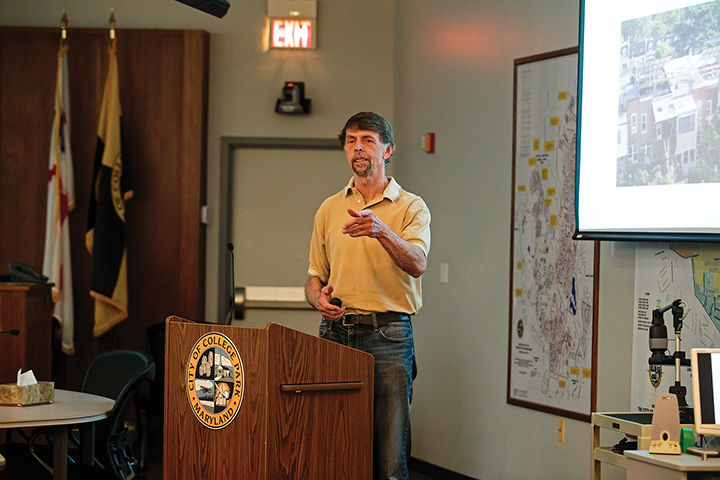
David Brosch, president of University Park Community Solar, LLC, speaks about his experience starting a community based solar co-op in the College Park City Hall on Wednesday May 6, 2015.
College Park residents gathered at City Hall last night to consider an initiative to have residents co-invest in solar panels in an effort to reduce the city’s carbon footprint.
With the initiative for a solar cooperative, city residents would pay for the installation of solar panels on a community building. The clean energy produced by the solar panels would reduce the need to purchase electricity from the local utility provider.
Those who invest in the solar panels could make their money back when the co-op sells excess electricity back to the grid.
“This is something that is necessary for all cities going forward,” said Eric Marshall-Main, a senior communication major who attended the meeting. “This is an example of how building renewable power can be profitable for the people who invest money in it that are not Pepco, but are individuals who make it work.”
In 2010, residents of University Park formed a private solar company to install 99 solar panels on the roof of a local church. The 35 residents who invested each put down an average of $4,000 for the $130,000 project. They also received a $40,000 federal grant.
As of May 1, these solar panels have generated 129,624 kilowatt hours of energy. By the end of 2013, the panels had sold enough energy back to Pepco to return 50 percent of the members’ investments. The group projects its investors will break even by 2017 and make a 7 to 8 percent return on their investment after the 20-year contract expires.
The leaders of the University Park project spoke to about 30 students and College Park residents during the meeting to share their story. The meeting was a first step in a community effort to establish a solar co-op in this city, said College Park Mayor Andy Fellows.
“The city of College Park is really poised to join our brothers and sisters in University Park in being leaders of municipalities in building a solar movement in Maryland,” Fellows said.
Since 2010, the price of solar panels has gone down significantly, and a similar project in this city could cost roughly half as much, said event organizer Eric Olson, the College Park City-University Partnership executive director.
“This may be the time if people are thinking about doing solar, talk to your closest friends and neighbors,” Olson said. “They’ve really blazed a path for us locally if people are interested in pursuing this option.”
Olson said the partnership doesn’t plan to lead the effort but would facilitate further meetings if community members take the initiative.
Annie Rice, a sophomore environmental science and policy major, said the meeting motivated her to get more involved.
“It’s totally feasible for College Park,” Rice said. “We’re bigger and we also have significantly more resources at our disposal. There’s the university and all of that brainpower coming together with city residents and even students.”
Ori Gutin, former SGA sustainability director, said even if students can’t afford to invest money, they could still help organize the initiative.
“Students can be integral around organizing folks in the community and raising awareness around the possibility,” Gutin said. “Students could work on developing the idea further and going door to door in College Park and bringing people together and saying, ‘We really want to see this in our community.’”



